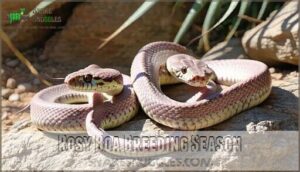This site is supported by our readers. We may earn a commission, at no cost to you, if you purchase through links.

You’ll need mature adults (3-4 years old), proper enclosures, and patience. Females produce 3-12 live babies after 4-month gestation, with healthy juveniles selling for $75-200 each.
Success hinges on selecting quality breeding stock, maintaining consistent environmental conditions, and building reptile community connections. Initial setup costs are modest compared to other species, making rosy boas ideal for beginners.
The real money-making secrets lie in timing, genetics, and market positioning strategies.
Table Of Contents
- Key Takeaways
- Breeding Rosy Boa Snakes
- How to Breed Rosy Boas Profitably
- Rosy Boa Breeding Season
- Marketing Rosy Boa Snakes
- Managing Rosy Boa Breeding Costs
- Frequently Asked Questions (FAQs)
- Are rosy boas hard to breed?
- How much can you make as a snake breeder?
- How to start a snake breeding business?
- How much money can snake breeders make?
- What is the most profitable reptile to breed?
- What do you need to be a snake breeder?
- How do genetics influence color morphs in rosy boas?
- Are there any specific laws regarding rosy boa exports?
- How do rosy boas compare to other snakes in temperament?
- What permits are required for commercial breeding?
- Conclusion
Key Takeaways
- You’ll need mature breeding adults (3-4 years old) and proper environmental conditions—maintain 80-85°F basking spots year-round, then trigger breeding with a 3-4 month cooling period at 55-65°F during winter months.
- Focus on rare morphs like albino or anerythristic varieties that sell for $300+ instead of standard offspring at $75-200, and maintain detailed genetic records to verify lineage and maximize your profit potential.
- Start with quality breeding stock and optimize your ratios using 2-3 females per male to maximize clutch yields, since healthy females produce 3-12 live babies after a 4-month gestation period.
- Build strong reptile community connections and research market trends to time your sales perfectly—successful breeders treat this as a business, not just a hobby, by tracking expenses and focusing on high-demand genetics.
Breeding Rosy Boa Snakes
Breeding rosy boas successfully requires understanding their specific environmental needs and natural behaviors.
You’ll need to create ideal conditions that mimic their desert habitat while managing breeding cycles, nutrition, and health monitoring to produce healthy offspring that command premium market prices.
Habitat and Environmental Conditions
Creating the perfect breeding environment starts with a 40-gallon enclosure minimum for adult pairs.
You’ll need a thermal gradient from 75-85°F with multiple hiding spots on both warm and cool sides.
Choose aspen shavings or cypress mulch as substrate, ensuring proper ventilation through screen tops.
Many keepers source their boa enclosure supplies online.
Temperature control and humidity control between 30-50% create ideal rosy boa breeding conditions in your breeding enclosures.
Feeding and Nutrition
When feeding rosy boas for breeding, you’ll want to adjust prey size to match each snake’s girth—typically mice or rats 10-15% of their body weight.
Feeding frequency matters: adults need meals every 10-14 days, while breeding females require more frequent nutrition during egg development.
Proper hydration methods include fresh water bowls changed weekly, and dietary variety isn’t essential since rosy boa breeding thrives on consistent rodent prey, though supplementation needs remain minimal with quality frozen-thawed options supporting ideal breeding nutrition for profitable snake breeding operations.
Maintaining proper humidity, around 40-60% is recommended, is also vital for their overall health and breeding success.
Reproductive Behaviors
Understanding rosy boa reproductive behaviors helps you master the breeding process.
Adult rosy boas reach sexual maturity around 3-4 years old, with females typically larger than males.
During breeding season, you’ll notice distinct courtship rituals and mating frequency patterns.
Key reproductive behaviors include:
- Males actively pursue females with chin-rubbing and body alignment
- Mating occurs multiple times during breeding season for higher success rates
- Females produce clutches averaging 3-10 offspring after successful reproduction
How to Breed Rosy Boas Profitably
Profitable rosy boa breeding requires strategic planning beyond basic husbandry knowledge. Your success hinges on understanding market dynamics and maximizing returns from each clutch. Snake breeding business profitability depends heavily on selecting the right genetic lineage and focusing on rare morphs that command premium prices.
Smart breeders prioritize clutch optimization by maintaining healthy breeding stock and timing reproduction cycles perfectly. Morph marketability drives your income potential, with specialty genetics often doubling standard sale prices. Rosy boas, including the coastal rosy boa, are popular among breeders.
Success in rosy boa breeding comes down to timing reproduction cycles perfectly and focusing on high-value morphs.
Here’s what separates profitable operations from hobby breeding:
- Focus on rare morphs like albino or anerythristic varieties that fetch $300+ per snake
- Maintain detailed genetic records to verify lineage and enhance offspring value
- Optimize breeding ratios with 2-3 females per male for maximum clutch yield
- Track breeder health scrupulously to guarantee consistent reproductive success
- Research reptile market analysis trends to anticipate demand shifts
Remember, breeding rosy boas profitably means treating it like a business, not just a passion project.
Rosy Boa Breeding Season
Understanding rosy boa breeding season timing is essential for maximizing your breeding success and profit margins.
You’ll need to create the right environmental conditions during their natural breeding cycle, which typically occurs from late winter through early spring when temperatures begin to fluctuate, allowing for a successful breeding season.
Maternal Care and Incubation
During throughout the entire gestation period, your breeding rosy boas handle egg development internally without external snake incubation methods.
Temperature stability between 80-85°F guarantees hatchling success, while humidity levels at 40-50% prevent complications.
Rosy boas also require a proper habitat setup to thrive during this time.
Unlike other snake eggs requiring incubation medium, rosy boa snakes are ovoviviparous—meaning no artificial setup needed.
Your gravid female becomes her own living incubator, making this process delightfully hands-off.
Caring for Neonates
Once your rosy boa snakes give birth, you’ll need to set up proper housing for the hatchlings. Each neonate requires individual containers with ventilated lids and thermal gradients of 80-85°F on the warm side.
After their First Shed occurs within 7-14 days, Initial Feeding can begin with pinkie mice. Consider the ideal enclosure products to guarantee proper care.
- Enclosure Setup: Use paper towels as substrate with shallow water dishes for easy cleaning
- Hydration Methods: Change water daily and maintain 40-60% humidity for healthy snake development
- Initial Feeding: Offer frozen-thawed pinkie mice once every 5-7 days after first shed
- Common Issues: Monitor for incomplete sheds and feeding refusal in your snake care routine
Health and Wellness Considerations
During breeding season, genetic screening prevents inherited defects while quarantine protocols protect your entire collection from breeding diseases.
Establish injury prevention measures in enclosures and maintain proper veterinary care relationships.
Monitor rosy boa morphs for unique health needs – some genetics require specific supplementation needs.
Quality reptile husbandry and proactive snake health management safeguard your investment and guarantee strong rosy boa genetics.
Marketing Rosy Boa Snakes
Successfully marketing your rosy boa offspring requires understanding your target audience and highlighting the unique qualities that set your snakes apart from competitors.
Transform your hobby into profit by showcasing premium genetics and exceptional care standards.
You’ll need to showcase proper care documentation, genetic lineage, and health certifications to build trust with potential buyers and command premium prices.
Proper Nutrition Requirements
When marketing premium rosy boa morphs, you’ll need to emphasize proper nutritional care to justify higher prices and build buyer confidence.
- Prey size should match snake’s thickest body section
- Feeding frequency varies: juveniles weekly, adults bi-weekly
- Supplementation needs include calcium dusting for gravid females
- Water quality requires dechlorinated, clean sources changed regularly
- Gut loading feeder rodents enhances nutritional value substantially
Quality snake breeding diet directly impacts reptile breeding profit potential.
Stress Reduction Techniques
Maintaining calm animals directly impacts your reptile breeding profit and customer satisfaction.
Stressed snakes produce fewer viable offspring and develop health issues that hurt your rosy boa for sale listings.
| Stress Factor | Solution |
|---|---|
| Overcrowding | Separate breeding pairs into individual enclosures |
| Excessive handling | Limit contact to feeding and health checks |
| Poor lighting | Provide 12-hour day/night cycles |
| Temperature fluctuations | Use reliable thermostats and backup heating |
| Loud environments | Place enclosures away from high-traffic areas |
Enclosure Enrichment helps rosy boa morphs express Natural Behaviors through hiding spots and climbing branches.
Handling Techniques should be gentle and infrequent during breeding season.
Quarantine Protocols prevent disease transmission between animals.
Minimize Social Interaction stress by housing snakes individually.
A solid reptile business plan includes stress management protocols that protect your investment and improve breeding success rates.
Disease Prevention Measures
Healthy snakes sell faster and command premium prices. Implement strict quarantine protocols for new animals, maintaining separate housing for 90 days minimum.
Practice rigorous hygiene practices between handling different snakes. Use probiotic supplements to boost immune systems naturally.
Regular parasite control through veterinary fecal examinations prevents costly outbreaks. Seal any openings to prevent snakes from entering enclosures.
Genetic screening eliminates hereditary issues that reduce your rosy boa for sale value substantially, ensuring you have healthy snakes and can command higher prices.
Managing Rosy Boa Breeding Costs
Successfully managing your breeding costs will determine whether your rosy boa venture becomes profitable or just an expensive hobby.
You’ll need to balance initial setup expenses with ongoing operational costs while maximizing your breeding output to achieve sustainable profit margins.
Profitability and Cost Management
Smart financial planning separates successful breeders from hobbyists who lose money.
Track every expense from initial breeding investment to snake sales using spreadsheets or apps.
Your breeding ROI depends on understanding which morphs generate the highest profit margins while monitoring market demand through platforms like Morph Market.
- Monitor breeding costs including food, utilities, and veterinary expenses monthly
- Research rosy boa morph list prices to identify profitable breeding combinations
- Calculate breeding profitability by comparing annual expenses against projected sales revenue
- Track market trends and adjust breeding investment based on current snake sales data to maximize your breeding investment and understand the market demand for specific morphs, ensuring you make informed decisions.
Substrate and Temperature Control
Paper towels might seem luxurious, but aspen shavings offer better value for your vivarium’s substrate needs.
You’ll create ideal temperature gradients using under-tank heating methods with proper thermal safety controls.
Controlled conditions require consistent monitoring—digital thermostats prevent overheating while maintaining the 75-85°F range essential for shedding success.
Proper substrate is key, so consider safe bedding options.
Quality temperature control systems pay for themselves through healthier breeding outcomes, which is the key to successful breeding.
Humidity and Lighting Requirements
Beyond temperature control, your reptile breeding setup needs proper humidity and lighting to keep costs low while maximizing breeding success.
Shedding humidity should stay around 50-60%, while UVB exposure isn’t required but basking lights help regulate day/night cycles for your boa snake care routine. Rosy boas require specific temperature gradients to thrive and avoid health issues.
Here’s your lighting spectrum checklist:
- 12-hour light cycles – Mimic natural rhythms without expensive UVB bulbs
- Night temperatures drop – Use ceramic heat emitters instead of costly lighting systems
- Seasonal adjustments – Gradually shift photoperiods to trigger breeding responses naturally
- Energy-efficient LEDs – Replace traditional bulbs to slash electricity costs long-term
Smart boa breeding tips include using timers and thermostats rather than manual adjustments. This reptile breeding guide approach prevents costly mistakes while your boa snake morphs develop properly.
Frequently Asked Questions (FAQs)
Are rosy boas hard to breed?
Rosy boas aren’t particularly hard to breed if you’ve got the basics down.
They’re actually quite forgiving compared to other snake species.
You’ll need proper temperature cycling and patience since they mature slowly.
How much can you make as a snake breeder?
Turning raw passion into profit isn’t just a dream—it’s achievable mathematics. You can earn $5,000-$25,000 annually with midsize operations, though success depends on breeding quality stock and market timing.
How to start a snake breeding business?
Start small: research popular snake species with good market value.
Acquire quality breeding stock, secure proper permits, set up housing systems.
Then gradually scale your operation as you gain experience and customers.
How much money can snake breeders make?
You’ll find snake breeding income varies widely depending on your operation size, species choice, and market conditions.
Midsize rosy boa breeders typically earn $5,000-$25,000 annually, with rare morphs commanding premium prices.
What is the most profitable reptile to breed?
Ball pythons typically dominate the most profitable reptile breeding scene.
Their docile nature and diverse color patterns create strong market demand, with prices ranging from $50 to $500, and rare morphs fetching even more.
With proper care, breeding females produce around six eggs per clutch, making them reliable income generators for dedicated breeders, due to their docile nature and ability to produce rare morphs.
What do you need to be a snake breeder?
Stepping into the serpent’s world requires dedication and preparation. You’ll need proper housing, heating systems, breeding pairs, basic veterinary knowledge, recordkeeping skills, and patience for the long-term commitment ahead.
How do genetics influence color morphs in rosy boas?
Genetics control rosy boa color morphs through recessive and dominant alleles that affect pigment production. You’ll see albino, anerythristic, and locality-specific traits when breeding compatible genetic lines together.
Are there any specific laws regarding rosy boa exports?
Passing through immigration-like checkpoints, your shipment of captive-bred beauties requires CITES Appendix II permits since rosy boas are protected internationally. You’ll need proper export documentation to cross borders legally.
How do rosy boas compare to other snakes in temperament?
You’ll find rosy boas remarkably docile compared to most snake species.
They’re naturally calm, rarely bite, and handle stress better than ball pythons or corn snakes, making them perfect beginner-friendly pets.
What permits are required for commercial breeding?
You’ll need state wildlife permits for captive breeding, which vary by location.
For commercial operations selling over $500 annually, federal USDA licenses become mandatory.
Check local city permits too.
A propagation permit is needed for breeding native reptiles.
Conclusion
Success in learning how to breed rosy boa snakes and make a profit isn’t guaranteed overnight.
You’ll face setbacks, unexpected expenses, and market fluctuations that test your commitment. However, those who master the fundamentals—proper cooling cycles, genetic selection, and customer relationships—consistently generate steady income streams.
Your dedication to maintaining ideal conditions, building reptile community connections, and reinvesting profits into superior breeding stock determines long-term success.
Start small, stay patient, and let compound growth work its magic, ensuring that you can build a strong foundation for your business and achieve steady income streams.












